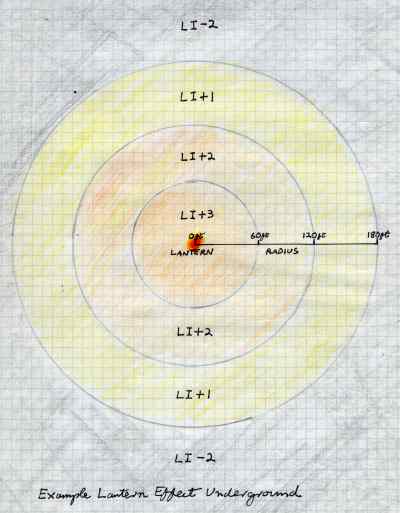Elementalist Spell Specification
Class: Fire
2. Illuminate

BTS: n/a
ULT: 60 hours
Materials: a Target flammable Object which could be used
to support an illuminating flame (although it is not actually burned or
consumed by the Spell Effect)
Actions: indicate Centre of Illumination by
gesturing towards or holding forth the material for the spell
Effect of Throw:
-2 to 7 Insanity
8 to 9 Flash of light to Caster's eyes: Caster takes Sg
-2 to -1 and DL+10 to Thievish Sg Observation Activities for 2 to 1 mins (no
st)
10 to 12 No Effect
13 to 26 Elven Lamp Effect (LI = +1,
Radius = 30 ft)
27 to 36 Torch Effect (LI = +2, Radius
= 60 ft)
³ 37 Lantern Effect
(LI = +3, Radius = 60 ft)
Duration: t hours -(t-1)
Range (to Target Object): 30d ft -d(d-1)/2
Notes:
- Illumination is Cast upon a Target Object (which counts as the Spell
Materials) and the Effect moves with that Object. There is no minus
for Casting on an Object.
- The Effect is a yellowish to reddish Light source, which counts as a
Magical Effect, but functions exactly the same as the equivalent natural Light source
(see the Light &
Darkness system). The Effect appears to be a flame, and counts
as Fire, but does no Damage (because it does not burn what it touches).
- The Radius is not a variable parameter, but is determined by Throw.
As for the equivalent natural Light source, the LI of the Torch Effect and
Lantern Effect deteriorate at -1 LI beyond that Radius for further
equal distances of 60 ft, down to LI +1. Beyond this they have no effect.
See the above graphic for an illustration of the Lantern Effect
underground in LI -2.
- The Illumination Effect shines out from the Target Object like light originating from a
Natural Light source.
It does not shine through major obstacles such as walls, nor around minor
obstacles such as bodies, and creates shadows behind anything occluding the
light path. The Target Object may be covered over by
non-flammable material (which would not qualify as Spell Materials) to block the
Illumination Effect as if the cover were a major
obstacle. Poorly flammable material may be penetrated by the
Illumination Effect at the DM's discretion.
- Light and Darkness are opposites which cancel each other out, but
multiple Light sources are not cumulative, nor are multiple Darkness
sources. To calculate the current LI at any given point start at LI 0, add
the strongest Light source, and subtract the strongest Darkness source. The
Illumination Effect is an exception to this rule (like lanterns, torches and fires underground),
and dispels up to two LI of shadow (one LI for the Elven Lamp Effect or
the LI +1 outer Radius of Torch or Lantern Effect), but does not dispel Darkness Spells.
- Infravision is impossible
(subject to the effects of any Darkness Spells or natural Darkness of LI
-3 or more) from any point within the total Radius of the
Illumination Effect. Outside the
total Radius of the
Illumination Effect, Infravision may still be
compromised by studying the light source (e.g. by Thievish Observation or Skrying effects) at
the DM's discretion.
- The full effects of Light and Darkness are as stated in the
Light and Darkness section of the Thief System.

